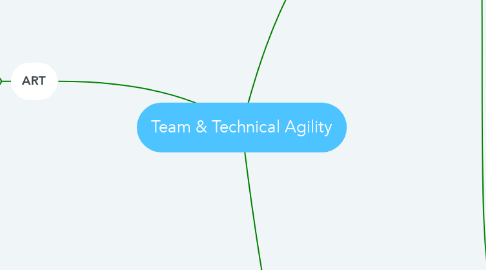
1. ART
1.1. 5-12 Agile teams (50-125+ individual)
1.1.1. Roles
1.1.1.1. RTE
1.1.1.1.1. Scrum master for train
1.1.1.2. System Architect/ engineer
1.1.1.2.1. defines the overall architecture of the system
1.1.1.2.2. Nonfunctional Requirements (NFRs), major system elements, subsystems, and interfaces.
1.1.1.3. Business Owners
1.1.1.3.1. key stakeholders of the ART and have ultimate responsibility for the business outcomes of the train.
1.1.1.4. product. management
1.1.1.4.1. is responsible for 'what gets built,’ as defined by the Vision, Roadmap, and new features in the Program Backlog.
1.1.1.4.2. They work with customers and Product Owners to understand and communicate their needs, and also participate in solution validation.
1.1.1.5. system team
1.1.1.5.1. assist in building and maintaining development, continuous integration, and test environments.
1.1.1.6. Customer
1.1.1.6.1. ultimate buyers of the solution
1.2. Continuous Delivery Pipeline
1.2.1. continuous exploration
1.2.2. continuous integration
1.2.3. continuous deployment
1.2.4. Release on Demand
1.3. Program Increment
1.3.1. program backlog
1.3.1.1. common mission
2. Scrum
2.1. Ceremonies
2.1.1. Iteration Planning -beginning
2.1.2. Stand up daily
2.1.3. Iteration Review
2.1.4. Retro
2.2. Flow
2.2.1. Kanban
2.2.1.1. Optimize
2.2.1.2. Visualize
2.3. Agile Team
2.3.1. atributes
2.3.1.1. cross function
2.3.1.2. self organised
2.3.1.3. 5-11
2.3.1.4. optimized to communication
2.3.2. Roles & Responsibilites
2.3.2.1. Create & Refine User stories
2.3.2.2. Deliver value per iteration (2w)
2.3.2.2.1. Define
2.3.2.2.2. Build
2.3.2.2.3. Test
2.3.2.2.4. Deploy
2.3.2.3. Develop and commit to team PI objective & iteration plans
2.3.2.4. Special Roles
2.3.2.4.1. SM
2.3.2.4.2. PO
2.4. built on
2.4.1. transparency
2.4.2. Inspection
2.4.3. adoption
2.4.4. short learning cycle
3. Built in quality
3.1. Ensure every increment reflect quality standard
3.2. Required
3.2.1. high sustainable development Velocity
3.3. Business & technical team practices
3.3.1. Established flow
3.3.1.1. Continuous Delivery Pipeline
3.3.2. Peer Review & Pairing
3.3.3. Collective ownership & Standard
3.3.4. DoD
3.3.5. Automation
3.3.6. technology focus team
3.3.6.1. Software quality
3.3.6.1.1. XP Practices
3.3.6.2. hardware quality
3.3.6.2.1. exploratory and early iteration
3.3.6.2.2. frequent
3.3.6.2.3. Model Based System Engineering
3.3.6.2.4. Set based design
3.3.6.2.5. design verfication
